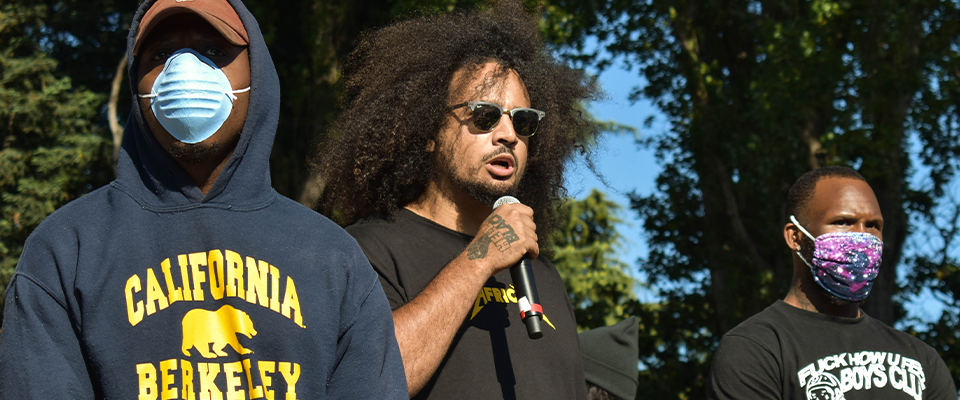Today, UC Berkeley’s first “universal” locker room, for people of any gender-ID and body type, opened to the public. At 4,500 square feet, it’s believed to be the largest universal locker room in California. Yesterday some lucky humans and I went on an exclusive tour of the inclusive space before its grand opening, and let me tell ya, I felt so A-list. Nothing says high-class like a bunch of people rubbing their chins and pursing their lips while looking at a toilet. I know because I watch people do it in the SFMOMA all the time!
The inspiration that spawned the universal locker room grew from a series of student complaints about feeling “unsafe” when using the traditional male and female locker rooms, says William Morrow, former president of the Associated Students of the University of California (ASUC).
“They were worried about body image, about this gendered binary that was making them feel unsafe,” Morrow explains. “[The Recreational Sports Facility] has this state of the art health and wellness facility that students were afraid to use because it’s not a place where they felt safe changing or taking a shower. To me, that hurt. And it became a focus for both myself, members of the RSF, and student leaders across the campus community.”

The new universal space wasn’t built in response to any LGBTQIA hate crimes occurring on campus, says Diana Hayton, an architect who worked on the locker room design, but was simply an effort to make people more comfortable. Of the people I spoke to who were involved in the locker room project, none were able to give an exact number for how many students voiced concerns, nor could they provide a total number of trans, non-binary, and genderqueer people on campus. In a 2013 recent campus climate survey, the most recent I could find, data reveals that about one percent of the entire campus community is transgender and/or genderqueer/gender non-conforming, with slightly higher numbers among undergraduates. And according to Berkeley’s 2016 UC Undergraduate Experience Survey, two percent of undergraduates are trans/genderqueer/gender-non-conforming.
With 30,000 undergraduates, says Andrew Eppig, institutional research analyst at Berkeley’s Office of Equity and Inclusion, this means at least 300 students are likely trans/genderqueer/gender-non-conforming. However, these numbers, which are self-reported by non-binary and trans students, may have increased over time.
Still, the locker room is hardly just for those who don’t fall into a cisgender category. It was designed specifically for disabled students as well, says former Rec Sports associate director Trineice Durst.
“We have a lot of folks who use our facility that have disabilities,” Durst says. “A lot of the time people are coming in with nurses or aids, and sometimes those aids are the same sex and sometimes they’re not. So where do they go when you only have gendered locker rooms? Where do they go when you don’t have an adult changing table? So this space is more than just a space for non-binary, trans and gender-nonconforming people.”

How many disabled students are expected to frequent the universal locker room? The number is hard to define, says Benjamin Perez, a disabled Cal alum and manager of Cal’s Campus Access Services, because it depends on how you look at disability.
“As far as people with visible physical disabilities, [there’s] a couple dozen, maybe a little bit more,” Perez says. “The Disabled Students’ Program right now, I believe, has 2,300 active enrolled students. And those are students with all types of disabilities, visible and non-visible.”
Even though the number of those who identify as disabled, non-binary or trans only make up a modest part of the student body, Perez seems certain that the locker room will be amply used, and by people of all kinds.
“There’s this idea in disability city planning called the curb ramp effect,” he explains. “The curb [ramps] are designed for people with disabilities so they can go up and down curbs, right? But we know that they’re used by everybody … Pregnant women with children who are pushing strollers, anyone who’s got a cane or a walker, people who are pushing heavy things, people with roller backpacks, everyone uses the curb ramp.”
In other words, Perez says: “If you build it, it will be used. I don’t know exactly what the population is going to look like, but I do know it will serve the intended purpose in addition to any other purposes.”
And Lossing, for her part, agrees. “I don’t think we will have enough space for everyone who wants to use the lockers. I’m afraid there will be long waiting lists. I’m afraid we’ll be victims of our own success.”
“The design helps with [privacy concerns] too, in that the two entries to the locker room are very large,” says Diana Hayton. “You can see into the space from the lobby.”
As I walked through the space, wishing I had a cigar or brandy to swirl while I observed the decadent, commemorative flower arrangements by the sinks, I was overtaken by the hugeness of the space. It’s an almost dreamy room in all its shiny newness, with soft blue walls and bright, department store lighting that illuminates every crevice of the space. (And, most likely, every crevice, back zit, and butt dimple, too.) However, concerns about revealing one’s bod to the masses shouldn’t be an issue, as the space was designed with the personal bubble in mind.
Rather than the public “gang style” layout (the term “gang style” being the most disquieting name imaginable for a public shower plan) where everyone washes naked to each other, there are seven private showers. There are also five private toilets, two of which are accessible to disabled people and one that has an adult changing table.
Also, changing in the communal area of the locker room is strictly forbidden, says Brigitte Lossing, RSF’s associate director; instead, people must disrobe in one of the 16 individual changing rooms. But with 400 lockers, the locker to changing room ratio is a bit suspect, and it’s unclear how that arrangement would work on a particularly busy day. I asked a few people involved in the project, and they weren’t so clear on the logistics either.
To address any safety concerns, security measures have been implemented. All of the changing rooms, bathrooms, and showers are designed with privacy in mind, including eight foot high partitions and full height doors, says Hayton.
And according to RSF rec operations coordinator Timothy Evans, they’re implementing what he calls “The Rove”—a student monitoring operation that is not, to my disappointment, a kind of future space police. “The Rove” (which I just love saying) is a group of student employees who periodically walk through the locker rooms to pick up towels and low-key scan to make sure everything is kosher—something done in both the male and female locker rooms as well. If anyone should decide to disrobe in the communal area, it will be dealt with post-haste.

“The design helps with [privacy concerns] too, in that the two entries to the locker room are very large. You can see into the space from the lobby,” Hayton says, adding that the removal of a concrete wall helped with visibility. She expects it’ll very quickly become clear that a “diverse crowd” frequents the space, which should discourage any funny business. “It’s going to self-police at some point.”
Speaking of funny business—and given that men haven’t historically had the best track record for respecting women’s privacy—some have expressed concerns about those who might try to take advantage of a coed, all-gender locker room scenario. According to data obtained earlier this month through a Freedom of Information request by the Sunday Times, unisex facilities in the UK are more dangerous for females than single-sex changing spaces, with two thirds of all sexual assaults at public swimming pools and leisure centers taking place in unisex changing rooms. Between 2017 and 2018, 134 incidents of harassment were reported, with 120 of those occurring in gender-neutral changing areas, and 14 happening in single-sex facilities. Of course, there’s no telling what the design and regulations of all those spaces are like, and they could be totally different from Berkeley’s uber-private, Rove-enforced version. And women don’t have to use it if they don’t feel comfortable, as the female and male locker rooms still remain.
When asked if she would use the facility herself, Lossing gave an emphatic, “Absolutely!” adding that having a space with changing rooms is very helpful to staff members who want to use the locker rooms but don’t want to go au naturel in front of their students right before educating them on ancient Egyptian art or astrophysics.
The money for the project came from a $2.7 million-dollar interest-free loan, but it will ultimately be paid for over the next 15 years by students—via the recently implemented “wellness fee.” In 2015, 60 percent of the student body voted in favor of a Wellness Referendum, says Morrow, which requires students to pay an annual fee of $146 for services dedicated to the physical and emotional health and well-being of students on campus.The following year, the ASUC, in partnership with then-Rec Sports associate director Durst, drafted a proposal for the universal locker room, which was then approved by the Wellness committee.
To Benjamin Chou, a freshman majoring in intended economics and computer science, adding a universal locker room to the campus seems like a natural progression. After all, he said, “There are already so many all-gender bathrooms on campus,” (45 to be exact), so a universal locker room wouldn’t exactly shake campus foundations. Plus, as a 2014 UMass Amherst report shows, all-gender bathrooms seem to be the new norm, with upwards of 150 colleges providing them, and likely more since the reporting.
Freshman Sara D’Ambrogia says the addition of the universal locker room likely won’t affect her experience because she always goes back to her dorm to change. But her overall response to the idea? “It’s cool.” Her sister, Kelly, a junior studying molecular engineering biology and Spanish, didn’t appear worried about privacy or security for women in a co-ed changing space. “Most people don’t care about [gender identity] when they go to the gym. They’re going to the locker room specifically to change and then work out.”
While the greater impact of the project remains to be seen, one thing is for certain: When it comes to universal locker rooms, there’s far more than toilets to contemplate.
Krissy Eliot is senior associate editor at CALIFORNIA. You can find more examples of her work at www.krissyeliot.com.





















